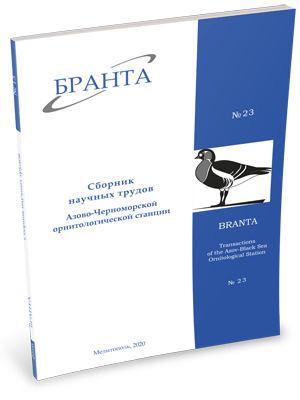
Transactions
of the Azov-Black Sea Ornithological Station



Settlement dynamics of the Isabelline Wheatear Oenanthe isabellina (Temm.) on the Crimean Peninsula
A. N. Tsvelykh 1, V. M. Kucherenko 2
2 – Taurida National V. I. Vernadsky University, Simferopol, Crimea Republic, Ukraine.
The expansion of Oenanthe isabellina in Ukraine began at the end of 1950s - early 1960s. The Isabelline Wheatear settled along the coast of the Sea of Azov from east to west and appeared on the Crimean Peninsula later than in the regions located to the west of it. Since the late 1960s, this species has been nesting near the mouth of the Dnipro River which located in the west of the Crimean Peninsula. The nesting of Oenanthe isabellina was found in the northern part of the Crimean Peninsula in 1973. In the mid-1980s, the Isabelline Wheatear inhabited the northwestern coast of Crimea and appeared far in the east - on the Kerch Peninsula. In the southeastern part of the peninsula the range of the Wheatear reached the Black Sea coast by the end of the 1980s, when the species nesting was found near Feodosia. In the southeastern part of Crimea, the Isabelline Wheatear continued to settle along the Black Sea coast in a westerly direction in the 1990s: its nesting was found near Sudak. In the central Crimea, the species range reached the northern foothills of the Crimean Mountains at this time. The species expansion to the south slowed down by the beginning of the 2000s. In the western Crimea, the southernmost settlement of the Isabelline Wheatear was found near Evpatoria. In the northern foothills of the Crimean Mountains (Central Crimea), the range border has not changed. There were no significant changes in the southeastern Crimea during this period - in the 2000s, O. isabellina nested near Sudak as in the 1990s. The species expansion almost stopped in Crimea in the 2010s. The settling of the Isabelline Wheatear in the steppe regions of the southwestern Crimea did not occur, possibly due to the absence of little ground squirrel settlements, whose burrows birds usually use for nesting. The border of the O. isabellina range has moved southward on about 100 km for three decades - from the beginning of the 1970s to the beginning of the 2000s -, i.e. the settlement speed of the species in Crimea was about 3 km per year.
Read the paper in a PDF fileReferences:
- Beskaravayny, M. M. (1996). New Data on Rare and Little-Known Bird Species of the South-Eastern Crimea. Vestnik zoologii, 3, 71-72 [in Russian].
- Beskaravainy, M. M., Kostin, S. Yu., & Tsvelykh, A. N. (2006). Preliminary results of inventory of the ornithofauna of cape Kazantip and the Kazantip Nature Reserve (the Crimea). Zapovidna sprava v Ukraini, 12 (1), 37-46 [in Russian].
- Dulitsky, A. I., & Tovpinets, N. N. (2015). Little ground squirrel. In Red Book of the Republic of Crimea. Animals (p. 391). Simferopol: ARIAL [in Russian].
- GBIF.org (18 August 2020) GBIF Occurrence. Retrieved from https://doi.org/10.15468/dl.6z3q74.
- Kinda, V. V., Beskaravayny, M. M., Dyadicheva, E. A., Kostin, S. Yu., & Popenko, V. M. (2003). Revision of rare, poorly studied and migratory species of passerine (Passeriformes) birds in the Crimea. Branta: Transactions of the Azov–Black Sea Ornithological Station, 6, 25–58 [in Russian].
- Knysh, N. P. (2001). Notes about rare and insufficiently known birds of the forest-steppe part of Sumy region. Berkut, 10 (1), 2–19 [in Russian].
- Kostin, Yu. V. (1983). Birds of the Crimea. Moscow: Nauka. [in Russian].
- Kucherenko, V. M., & Kucherenko, E. E. (2014). Preliminary results of ornithofauna investigation of National Natural Park «Charivna Gavan’» (Crimea, Ukraine). Zapovidna sprava, 1(20), 92-97 [in Russian].
- Loskot, V.M. (1969) Distribution of the Isabelline Wheatear on the territory of the Ukrainian SSR. In Study of the resources of terrestrial vertebrates of the fauna of Ukraine. Materials of the republican coordination meeting on the problem “Biological bases of development, transformation and protection of the animal world”. January, 29-31, 1969. Kiev: Naukova Dumka [in Russian].
- Panov, E. V. (1999). Wheatears of the Palaearctic: ecology, behavior, evolution. Moscow: Partnership of scientific publications KMK [in Russian].
- Peklo, A. M. (2002). Catalogue of collections of the Zoological Museum, NSNHM, NAS of Ukraine. Birds, 3. Kiev: Zoological Museum NSNHM NAS of Ukraine [in Russian].
- Redinov, K. O., & Petrovich, Z. O. (2010). To the specification of range border of the Isabelline Wheatear in the South-West of Ukraine. Berkut, 19 (1-2), 197-198 [in Ukrainian].
- Sharleman, N. V. (1948). Finds of Corsac and Isabelline Wheatear in Ukraine and their zoogeographic significance. Priroda, 9, 67-69 [in Russian].
- Soares, D. (2010). Checklist S40080740. Retrieved from https://ebird.org
- Zyskowski, K. (2019). Checklist: S60632715, S60633022, S60644961. Retrieved from https://ebird.org